Founded in 2009, Girl Museum is a virtual museum dedicated to preserving, documenting, and sharing the history of girlhood and female empowerment. Unlike other museums, Girl Museum doesn’t have a physical building that people can visit. Instead, the museum has a website with virtual exhibitions that people can interact and engage with online. (“Impact”. Girl Museum https://www.girlmuseum.org/about/impact/) This paper will explore, the history of Girl Museum, what a virtual exhibition is, how the staff at Girl Museum curate their exhibtions, and the future of Girl Museum. To provide more in-depth information on Girl Museum and how the staff curate their virtual exhibitions, I have included summaries and video clips from two interviews that I conducted with the Founder and Head Girl Ashley E. Remer and the Education Advisor Hillary Rose at Girl Museum.
What is Girl Museum?
Girl Museum is a virtual arts and social history museum that is run entirely by volunteers. Unlike a traditional museum, Girl Museum has no stanchions or offices, no personal collection, and no paid staff. The museum was founded by Head Girl Ashley E. Remer, a current PhD student at Australian National University in Art History. The museum is also overseen by a Board of Directors, an Advisory board of scholars, and a senior staff of long-term volunteers dedicated to specific programs and projects including Education Advisor Hillary Rose. The museum also has a team of Junior Girls, which includes interns and younger volunteers. (“Impact”. Girl Museum https://www.girlmuseum.org/about/impact/) A year into the museum’s creation, Remer quickly realized that she needed to hire interns to help with the overwhelming amount of work that she had to create the museum. The overwhelming number of responses from women in a variety of fields across the world exceeded Remer’s expectations. In 2010, Remer assembled a team of seven interns from around the world, which became the first cohort of Junior Girls. The interns helped create exhibitions, write for the blog, apply for grants, and explore other resources and projects for the museum. Many of those interns became long term volunteers and are still on the staff today. (Ashley Remer, “Girl Museum: a Global Project, Girlhood Studies” Girl Museum (blog) (2010), 140-148.) This is a testament to the incredible dedication and passion that makes Girl Museum possible.
The Girl Museum
The Girl Museum has 39 virtual exhibits, a podcast called GirlSpeak, a blog, and many other resources for its visitors. The GirlSpeak podcast is currently on hold, but past episodes can be found on their website as well as Spotify and Apple Podcasts. Girl Museum also has an Instagram, Facebook, YouTube channel, and a Twitter page where they are able to market their virtual exhibits, podcast episodes, and share additional content on the history of girls and girlhood. (“Impact”. Girl Museum https://www.girlmuseum.org/about/impact/) In the past, the museum had also created a few online exhibits on Tumblr, but they are no longer on the site. The main focus of Girl Museum are their virtual exhibits, which are broken into four sections –– Girlhood in Art, Art of Girlhood, Girls in the World, and Contemporary Art. (“Exhibitions.” Girl Museum, July 3, 2022. https://www.girlmuseum.org/view/exhibitions/.") Unlike museums that highlight the digitized objects from their personal collection or others within the same institution (ie. Smithsonian museums sharing objects with each other), Girl Museum uses copyright-free and open access digitized objects from other museum collections in their virtual exhibits. In displaying the objects in their exhibits, Girl Museum highlights art, history and cultural institutions from around the world. One challenge in this model, however, is that some museums have begun to copyright their digitized objects, forcing the museum to pay to use them. Girl Museum has limited funds and cannot always afford to pay for those copyrights. (Remer, Ashley. Recorded interview via Zoom with author, October 20, 2023.)

What are Virtual Exhibitions?
Virtual exhibits, also referred to as digital exhibits, are an ensemble of interlinks curated in a section of a museum’s website that has the objective to disseminate digital multimedia content to deliver innovative presentations of a concept or movement. Virtual exhibits are similar to physical exhibits in that curators have to think constructively about the theme or concept that will help to tie the objects together. The main objective of exhibitions is to provide a space for the presentation of artifacts, art pieces, and other objects that serve as a center of knowledge specialized in a thematic area. (Gabriela Dumitrescu, Cornel Lepadatu, and Cristian Ciurea, “Creating Virtual Exhibitions for Educational and Cultural Development,” Informatica Economica 18, no. 1/2014 (2014): 102-10, https://doi.org/10.12948/issn14531305/18.1.2014.09.)
Implementing a virtual exhibit doesn’t simply mean publishing images of cultural objects in a gallery; it involves creating an interesting software product that supports the visitor’s experience. (Ciurea, Cristian, and Florin Gheorghe Filip. “Virtual Exhibitions in Cultural Institutions: Useful Applications of Informatics in a Knowledge-Based Society.” Studies in Informatics and Control 28, no. 1 (2019): 55-64. https://doi.org/10.24846/v28i1y201906) In 2009, Remer wanted the Girl Museum’s first website to feel as if a museum was virtually stepping into a museum. The homepage had white stone columns on either side similar to those founded on the front of many museum buildings around the world. Each virtual exhibit had a separate background color and font that would make it feel as if visitors were entering different rooms of a museum. (Remer, Ashley. Recorded interview via Zoom with author, October 20, 2023.) Early scholars in the field argued that the 2D interface leaves little to no room for an immersive experience, whereas a 3D virtual recreation of a physical exhibition or museum allows visitors to navigate the virtual scenario in a way that is closer to the reality of walking through the physical building. Unfortunately, the software tools associated with creating the 3D model of virtual exhibitions are not always accessible to museum staff as they require sophisticated and expensive equipment. (Ciurea, Cristian, and Florin Gheorghe Filip. “Virtual Exhibitions in Cultural Institutions: Useful Applications of Informatics in a Knowledge-Based Society.” Studies in Informatics and Control 28, no. 1 (2019): 55-64. https://doi.org/10.24846/v28i1y201906) Despite the good intentions that came with wanting to create a virtual museum that resembled a physical museum, Remer states that she found the initial website for the museum to be too busy and overwhelming for visitors. Over the years, she has found that their current style, though simple, is the most accessible, sustainable, and effective way to entice and engage visitors in the museum’s many virtual exhibits. (Remer, Ashley. Recorded interview via Zoom with author, October 20, 2023.)
How Girl Museum Curates Their Virtual Exhibits
Curating a virtual exhibit at Girl Museum begins with a meeting between Remer, Rose, and the curators where they discuss what the exhibit is going to be about, what will be featured at the exhibit, and how long the exhibit will take to create from start to finish. According to both Remer and Rose, exhibits normally take anywhere from 1-3 years to complete, but the museum’s staff can be flexible with that timeline to take advantage of opportunities that come up quickly. After the initial meeting, a Google doc is created where those who are working on the exhibit are able to put digitized photos of the objects that will be featured in the exhibit, research done on the topic of the exhibit, and other important information relevant to the exhibit. This Google doc allows the volunteers to gather information for the exhibit on their own schedule without having to deal with multiple meetings, especially since the volunteers are located around the world. The team of volunteers that are working on the exhibit, along with Remer, will then begin to draw an outline as to what the exhibit is going to look like on the website. The information is then brought to the Program Manager Tiffany R. Isselhardt who inputs the exhibitions onto the website, which is located on Wordpress. The team then checks the exhibit for any spelling and grammar mistakes before it is posted to the public. Right before the exhibit goes live, Rose and a few other volunteers will then begin to create an Educational Guide PDF for the exhibit that teachers and parents can use with young children to help them further engage with the information and topics explored in the exhibit. Rose and Remer are always seeking to find new ways to use the online space to the fullest to provide many resources for girls around the world. For instance, many of the Girl Speak podcast episodes are attached to the virtual exhibits along with videos and other sources of media that help to make the exhibits more engaging and interactive to visitors. (Remer, Ashley. Recorded interview via Zoom with author, October 20, 2023.) (Rose, Hillary. Recorded interview via Zoom with author, October 20, 2023.)
Girl Museum’s Virtual Exhibits
Defining Our Terms is a virtual exhibit that provides an overview to the history of girls and girlhood. This exhibit is Remer’s personal favorite and one that she advises many first-time visitors take a look at to gain a better understanding as to the type of work that the museum is hopping to do with their other virtual exhibits. The exhibit is broken down into four sections Girlhood in Art, Art of Girlhood, Girls in the World, and then lastly GirlSpeak. The exhibit tackles a variety of issues concerning young girls throughout the world and highlights important young girls in history including Anne Frank. There is an education guide at the bottom of the exhibit that encourages visitors to answer questions about the exhibit, analysis the images that are found throughout the exhibit and activities that young girls can do to help them further engage with the information provided in the exhibit. (Girl Museum. Defining Our Terms. https://www.girlmuseum.org/project/defining-our-terms) This exhibit doesn’t include multimedia content, but instead provides visitors with a lot of in-depth information on a variety of topics. The long forum of in-depth information present in Defining Our Terms is not something that can always occur in physical museums, due to a lack of space.
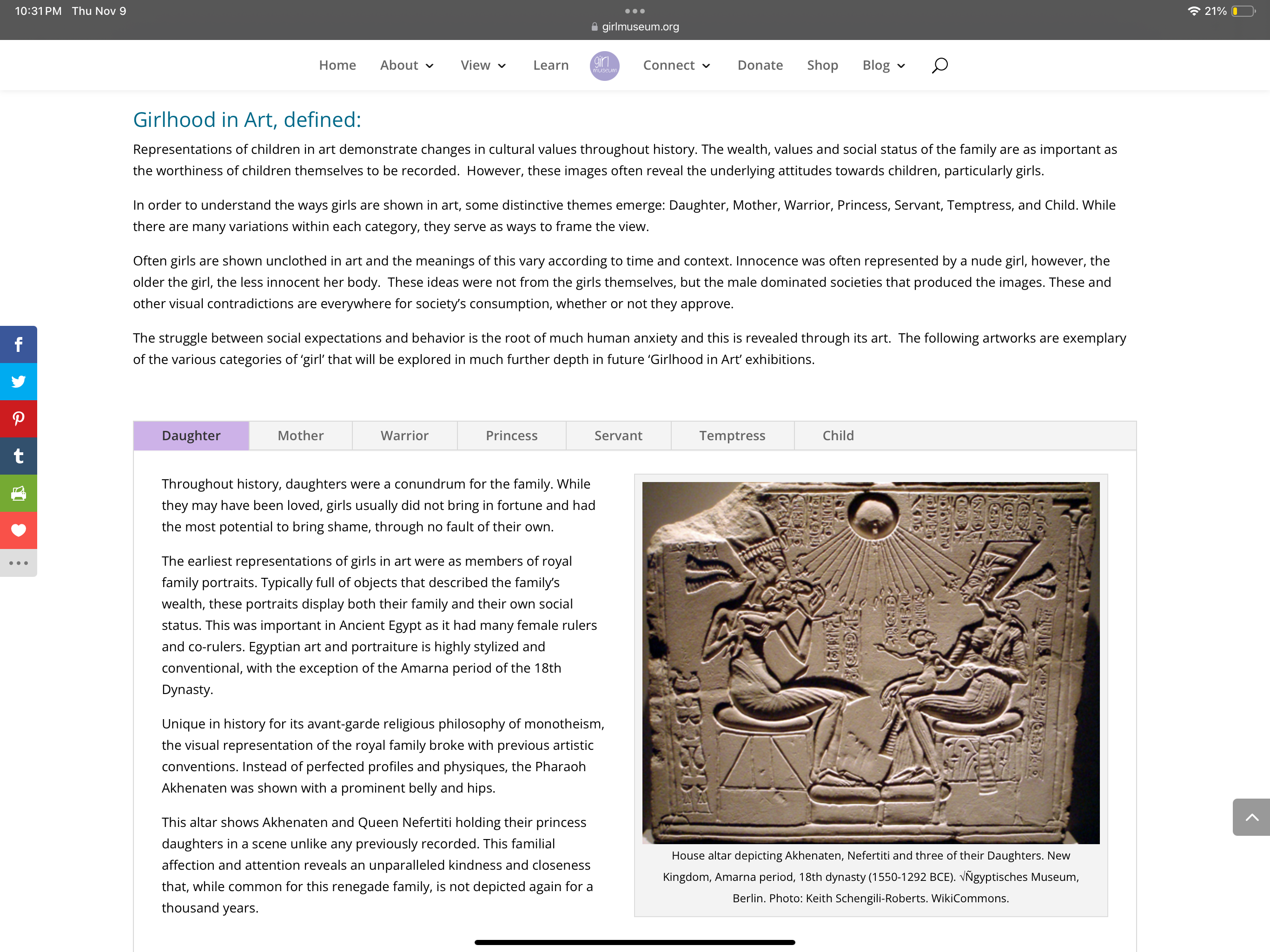
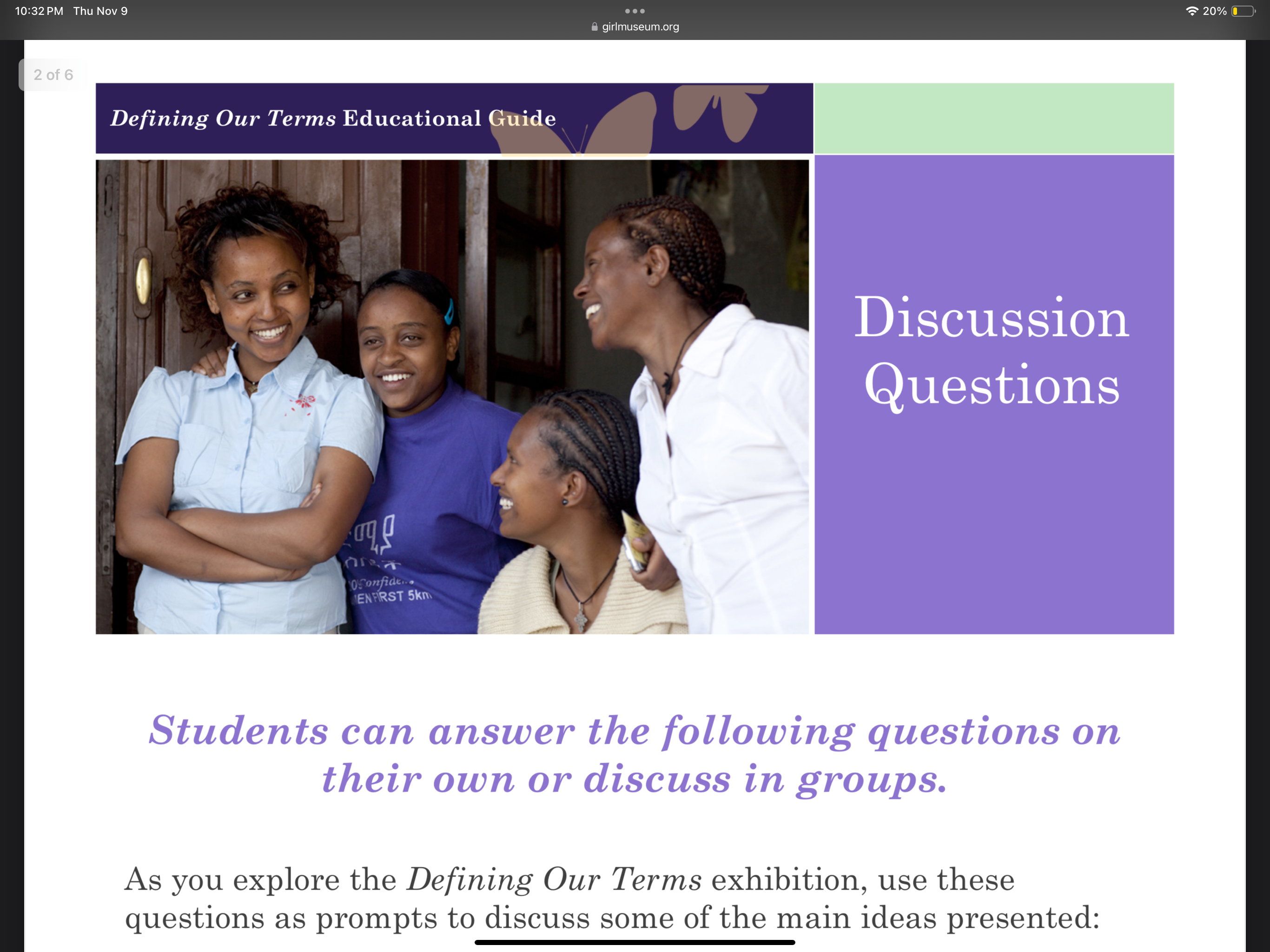
The virtual exhibit 52 Objects in the History of Girls is one of Rose’s favorite exhibits that she has taken part in creating at the museum as it explores fifty-two objects that represent girls and girlhood from many different cultures located around the world. (Rose, Hillary. Recorded interview via Zoom with author, October 20, 2023.) The exhibit was released in 2017 and featured a new object each week. The exhibit has an interactive map from Google maps that pins each object in the exhibition to its country of origin. Each object is also featured on the main page of the exhibit with a short description that visitors can click on to be sent to a blog post that provides more in-depth information on the object and its culture of origin. The blog posts were written by the volunteers at the museum. (Girl Museum. 52 Objects in the History of Girls. https://www.girlmuseum.org/project/52-objects/) Despite this exhibit’s simple forum, the map provides an interactive element to the exhibit and the blog posts allow for more long forum descriptions that provide in-depth information on the cultures and the objects. The blog posts in the 52 Objects in the History of Girls exhibit provides visitors with more information than they would normally receive from a physical exhibition. This results in an exhibition that enhances the visitor experience for those who may enjoy seeing the objects in a physical exhibition but am wanting to learn more about them.
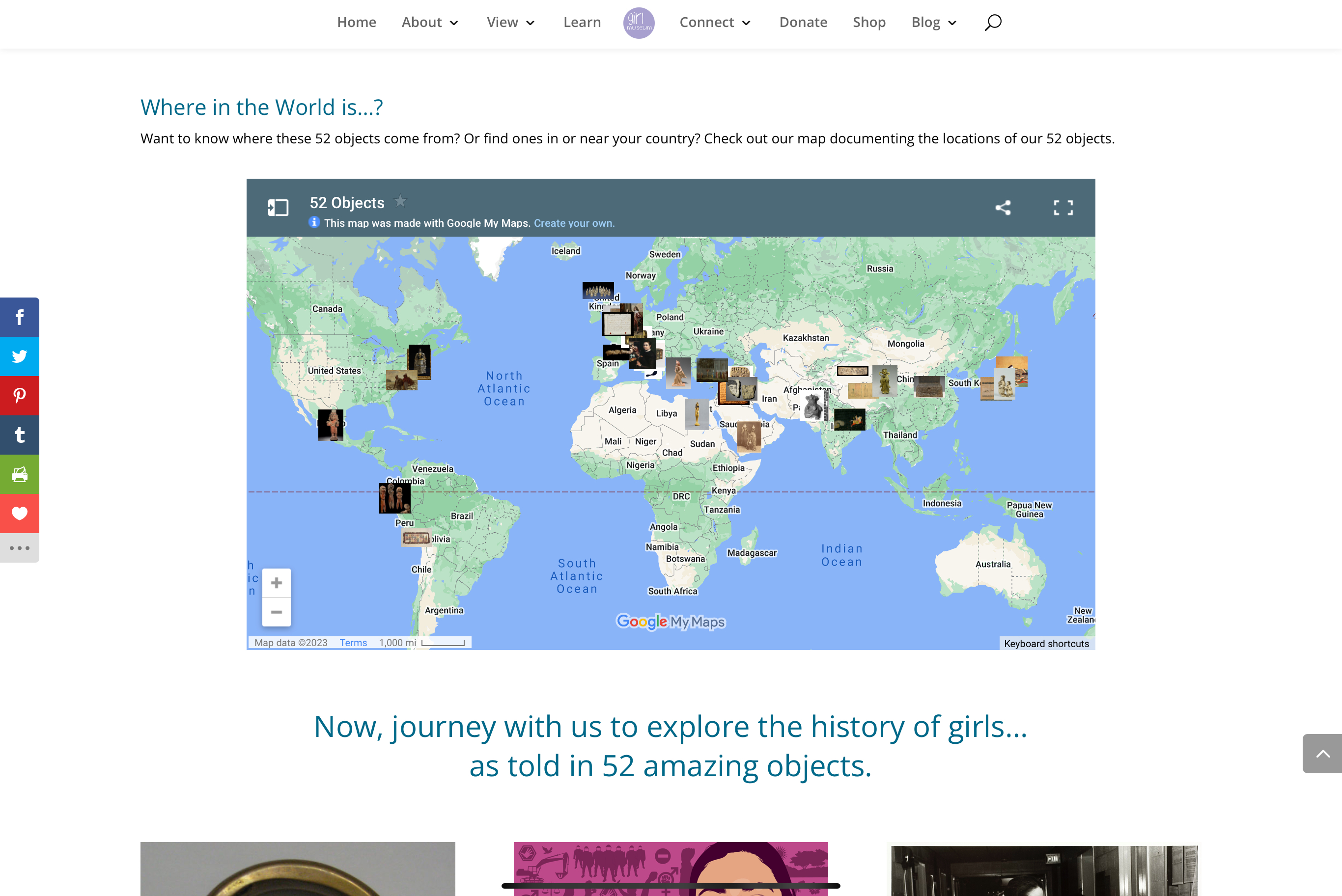
Other ways that Girl Museum uses the online space more fully in their virtual exhibitions is by providing links to organizations that greatly impact girls around the world, youtube videos and other sources of multimedia content that help to provide more context and infromation to the topic of the exhibit, and posting comments made by young girls and women around the world on what a girl means to them. (“Exhibitions.” Girl Museum, July 3, 2022. https://www.girlmuseum.org/view/exhibitions/.") All of these different resources produce a virtual exhibition that takes full advantage of the limitless space that the internet has to offer for museums. Despite not feeling as if visitors are clicking through virtual reality versions of physical exhibits. Girl Museum has continued to find ways to make their 2D interface as interactive and engaging as possible to visitors. This has resulted in Girl Museum creating virtual exhibitions that many other museums could use as a blueprint when curating their virtual/digital exhibitions.
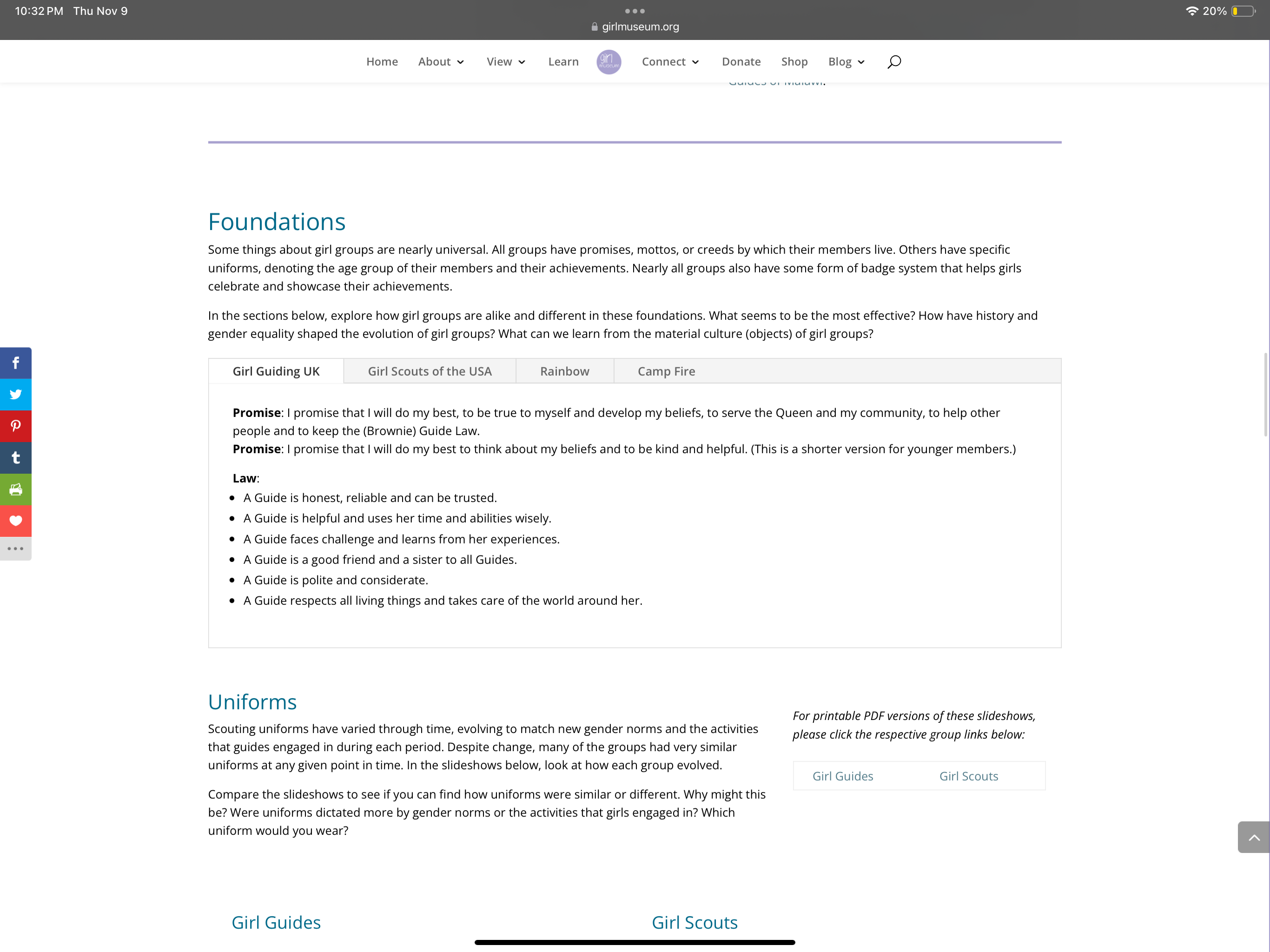
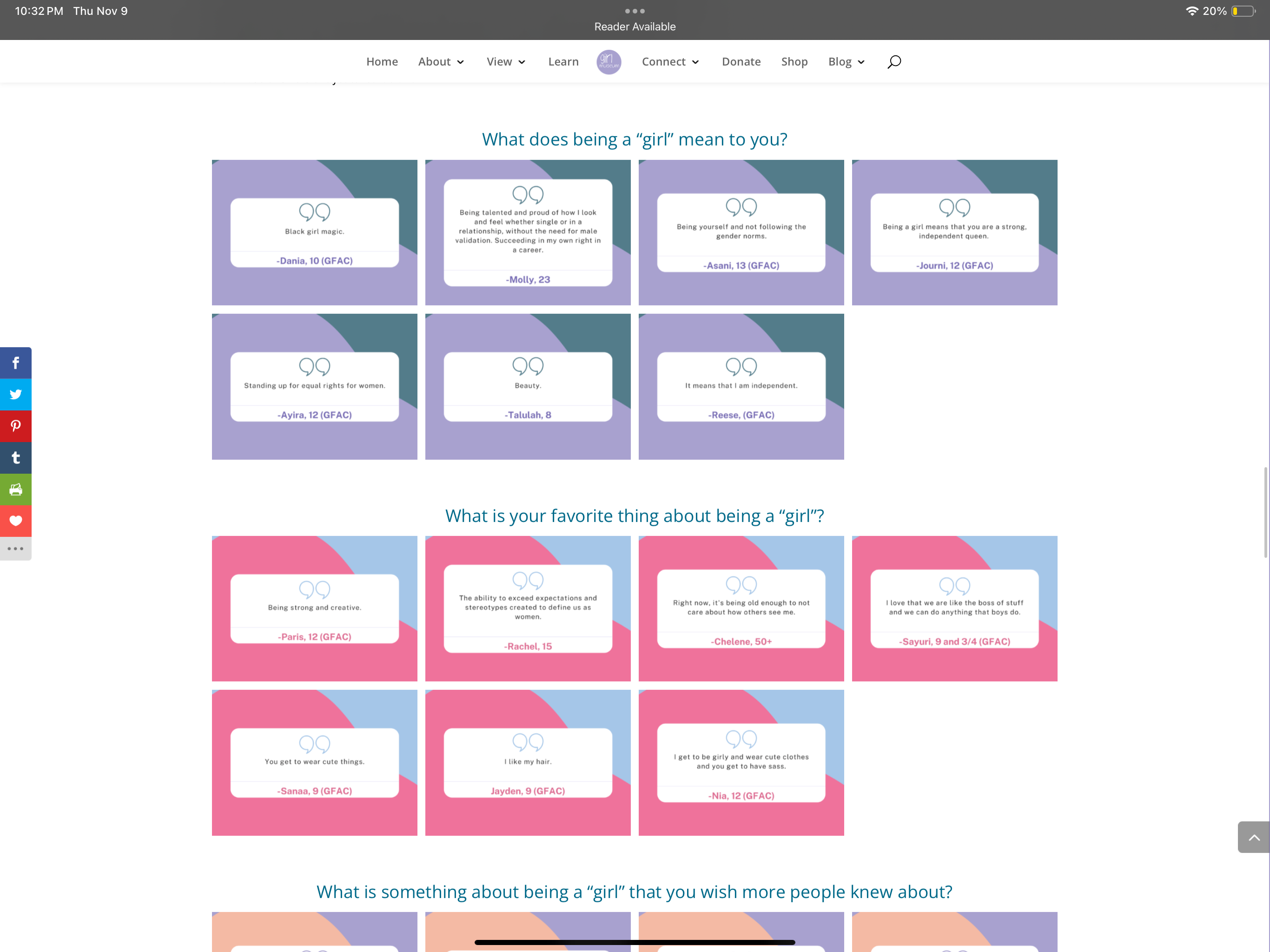
Evaluating Success
Accessibility to another essential characteristic of virtual exhibits. This became essential during the Covid-19 pandemic when many museums closed their doors to the public after people were told to stay at home and socially distance in order to help slow down the virus. Virtual museums allow for visitors from the local community and around the world to visit and interact with objects without the limitations of time or location. During the Covid-19 pandemic, it became increasingly clear to museums that they should have digital/virtual exhibits that go along with their physical exhibits. (Burke, Verity, Dolly Jørgensen, and Finn Arne Jørgensen. “Museums at Home: Digital Initiativesin Response to COVID-19.” Norsk museumstidsskrift 6, no. 2 (2020): 117-23. https://doi.org/10.18261/issn.2464-2525-2020-02-05.)
Another challenge for Girl Museum is that it is illegal for anyone to track the data of children under eighteen years old. Unfortunately, Girl Museum’s target audience is children between twelve- and eighteen-year-old girls. The museum has begun to roll out a survey to teachers that would hopefully help to guage how teachers have found the museum’s exhibitions helpful in the classroom. With the help of Google analytics, the Museum is able to track their visitors who are above the age of eighteen years old. According to their 2022 Yearly Report, Girl Museum brought in about 172,210 visitors, their high-test attendance yet, with 187 new community members and produced 3 new exhibitions. About 60 percent of the visitors identified as female, with about 32% being between ages 18-24, with most of their visitors coming from the United States, United Kingdom, and India. (“Impact”. Girl Museum https://www.girlmuseum.org/about/impact/) Despite not being able to gather information on their target audience, this data still highlights that the virtual exhibitions are receiving positive feedback from visitors.
Looking into the Future:
Despite their decision to produce exhibitions that use the 2D presentation model, the staff at Girl Museum, have been interested in curating an exhibit that would be a 3D virtual reality simulation of a physical exhibit. The exhibit would have walls and digitized replications of art pieces and other objects that visitors could virtually walk through using a VR headset or click through with their mouse. The museum was in contact with a few people at a major software company to make a prototype of a virtual reality exhibit that Girl Museum would later be able to put on their website. After a few emails, the staff at the major software company decided to not purse the project further. Due to a lack of funding, they aren’t able to curate a 3D virtual reality simulation of a physical exhibit on their own to post to the website without having a team of volunteers that would be able to produce the project. (Remer, Ashley. Recorded interview via Zoom with author, October 20, 2023.) (Rose, Hillary. Recorded interview via Zoom with author, October 20, 2023.) Even though Remer doesn’t believe that they are missing anything by not producing 3D virtual reality exhibitions. However, Remer and the rest of the staff at Girl Museum are always looking for ways to expand their resources.
Girl Museum has recently released an exhibit titled Sitting Still that include 45 paintings, miniatures, prints, and watercolors from public and private collections around the world that are from the 15th century through to the mid 20th century of girls sitting. (“Exhibitions.” Girl Museum, July 3, 2022. https://www.girlmuseum.org/view/exhibitions/.") The two other exhibits in this series are currently in production mode and will be released in 2024 and 2025. Currently, the staff at Girl Museum are also reflecting on all their exhibits, the podcast, the blog, and the other resources that are on the website to see how they can better serve their visitors. In the future, Remer and the staff would like to produce documentaries, short films, classes, an online database on girlhood, and many other resources aside from the virtual exhibits. (Remer, Ashley. Recorded interview via Zoom with author, October 20, 2023.) (Rose, Hillary. Recorded interview via Zoom with author, October 20, 2023.) Even though the virtual exhibits are a big focus of the museum, the staff are constantly coming up with new projects that better serve girls around the world. Once the staff curates a list of projects that they would like to create, the staff will then begin to contact institutions and organizations that the museum could potentially partner with on these projects, along with writing grants that would help them receive some additional funding to put into these projects. In the future, Remer would also like to be able to get a technology volunteer that would be willing to work on figuring out more ways that the museum could help to make some of these projects happen. (Remer, Ashley. Recorded interview via Zoom with author, October 20, 2023.)
Conclusion
Girl Museum showcases that a small insitution with a limited budget and a staff of volunteers can curate effective, accessible, and engaging virtual exhibitions. Even though the staff at Girl Museum would like to curate a 3D virtual reality simulation of a physical exhibition, they are continuing to invest in various other resources that can help to serve more girls around the world. When it comes to the future, the staff at Girl Museum would like to provide important resources to young girls in any way they can. Museums should use Girl Museum as a blueprint when curating an online presence that could better serve visitors located in the community and around the world.
Bibliography
- Ashley Remer, “Girl Museum: a Global Project, Girlhood Studies” Girl Museum (blog) (2010), 140-148.
- Burke, Verity, Dolly Jørgensen, and Finn Arne Jørgensen. “Museums at Home: Digital Initiativesin Response to COVID-19.” Norsk museumstidsskrift 6, no. 2 (2020): 117-23. https://doi.org/10.18261/issn.2464-2525-2020-02-05.
- Ciurea, Cristian, and Florin Gheorghe Filip. “Virtual Exhibitions in Cultural Institutions: Useful Applications of Informatics in a Knowledge-Based Society.” Studies in Informatics and Control 28, no. 1 (2019): 55-64. https://doi.org/10.24846/v28i1y201906
- “Exhibitions.” Girl Museum, July 3, 2022. https://www.girlmuseum.org/view/exhibitions/."
- Gabriela Dumitrescu, Cornel Lepadatu, and Cristian Ciurea, “Creating Virtual Exhibitions for Educational and Cultural Development,” Informatica Economica 18, no. 1/2014 (2014): 102-10, https://doi.org/10.12948/issn14531305/18.1.2014.09.
- Girl Museum. 52 Objects in the History of Girls. https://www.girlmuseum.org/project/52-objects/
- Girl Museum. Defining Our Terms. https://www.girlmuseum.org/project/defining-our-terms
- “Impact”. Girl Museum https://www.girlmuseum.org/about/impact/
- Remer, Ashley. Recorded interview via Zoom with author, October 20, 2023.
- Rose, Hillary. Recorded interview via Zoom with author, October 20, 2023.